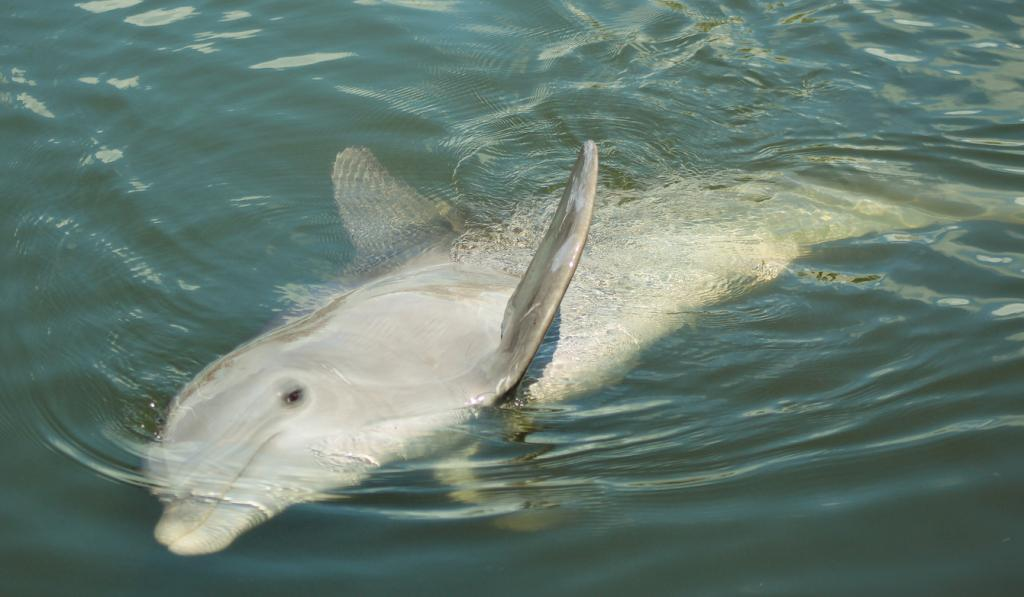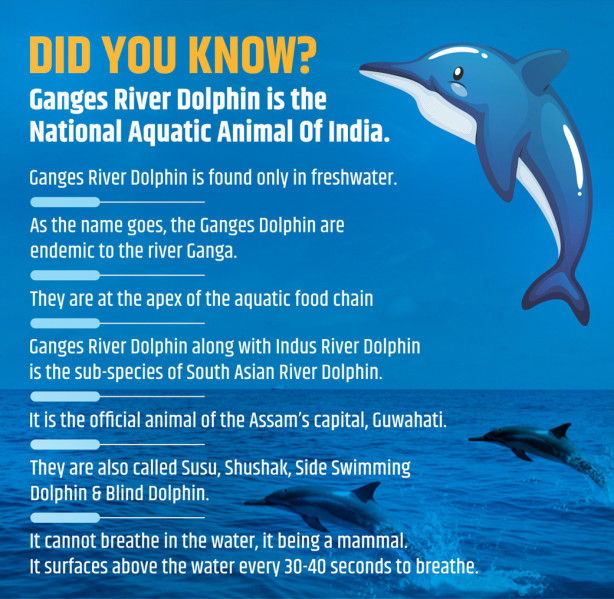Description

Copyright infringement not intended
Picture Courtesy: https://www.downtoearth.org.in/news/wildlife-biodiversity/india-s-first-national-dolphin-research-centre-finally-a-reality-94790
Context: India's first National Dolphin Research Centre (NDRC) has been established in Patna, Bihar, marking a significant milestone in the conservation efforts for the endangered Gangetic river dolphin.
Details
- The National Dolphin Research Centre (NDRC) aims to facilitate comprehensive research on Gangetic dolphins, covering various aspects such as behaviour, survival skills, food habits, causes of death, and more. The centre will provide training to fishermen on conservation and protection measures for dolphins during fishing activities.
Gangetic River Dolphin
- The Gangetic River dolphin (scientifically known as Platanista gangetica) is a freshwater dolphin species found in the Ganges and related rivers of South Asia, including India, Nepal, and Bangladesh.
- It is one of four freshwater dolphin species in the world and is closely related to the Indus River dolphin, which inhabits the Indus River in Pakistan and the Beas River in northwestern India.
|
Freshwater dolphin species in the world
|
|
Species
|
Habitat
|
Conservation Status
|
Interesting Fact
|
|
Amazon River Dolphin (Inia geoffrensis)
|
Amazon River basin and tributaries in South America
|
Data Deficient
|
Known for their pink colouration, especially in males.
|
|
Ganges River Dolphin (Platanista gangetica)
|
Ganges and Brahmaputra rivers in India, Nepal, and Bangladesh
|
Endangered
|
Nearly blind and relies on echolocation for navigation and hunting.
|
|
Indus River Dolphin (Platanista minor)
|
Indus River in Pakistan
|
Endangered
|
One of the most endangered dolphin species due to habitat loss and pollution.
|
|
Irrawaddy Dolphin (Orcaella brevirostris)
|
Mekong, Ayeyarwaddy, and Mahakam rivers in Southeast Asia
|
Critically Endangered
|
Known for their friendly and playful behaviour.
|
Geographical Range and Regional Names
- These dolphins inhabit the Ganges-Brahmaputra-Meghna and Karnaphuli-Sangu river systems in Bangladesh and India, including the Sapta Koshi and Karnali Rivers in Nepal.
- Known by diverse names like Susu, Hihu, Shushuk, and others, their presence holds cultural significance in the region.
Appearance and Behavior
- With a rectangular dorsal fin and females larger than males, Gangetic River Dolphins exhibit colours ranging from tan to chocolate brown.
- They possess an elongated snout, sharp teeth, and a distinctive melon head for echolocation. Typically swimming alone or in pairs, they breach rarely and maintain a shy demeanor around boats

Vocalization and Echolocation
- The Gangetic Dolphin showcases remarkable echolocation capabilities, navigating the murky river waters effectively. Echolocation sounds, including clicks, bursts, and twitters, help them identify prey. While they can perform whistles, it is rare, suggesting these sounds are more spontaneous than communicative.
Reproduction and Diet
- Mating occurs without a specific season, with calves staying close to their mothers for a year.
- The Gangetic River Dolphin, relying on echolocation, feeds on crustaceans, various fish, birds, and even sharks like the Ganges shark.
Threats and Conservation
- Listed as an endangered species, these dolphins face multifaceted threats, including habitat fragmentation, fishing gear entanglement, pollution, and climate change.
- Conservation efforts involve legal protection, designation of sanctuaries, and initiatives like 'Project Dolphin' to bolster their survival.

Conclusion
- The establishment of India's first National Dolphin Research Centre represents a significant step forward in the conservation of Gangetic river dolphins. By fostering research, training, and conservation efforts, the NDRC is poised to make a substantial impact on the protection of these endangered mammals and their fragile aquatic ecosystem.
|
PRACTICE QUESTION
Q. How do Ganges River Dolphins navigate murky waters?
A) Excellent eyesight
B) Echolocation using sound waves
C) Following other dolphins
D) Using the Earth's magnetic field
Answer: B
Explanation: Despite being partially blind, Ganges River Dolphins are excellent hunters thanks to echolocation. They emit high-frequency sounds that bounce off objects, creating a mental map of their surroundings.
|













